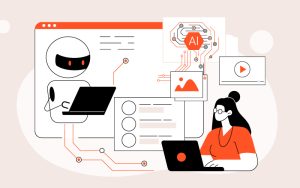So, if you are an instructional designer, you might be wondering: Will AI take my job?
The short answer? Not if you adapt.
While AI is undoubtedly changing the nature of work, it’s not intended to replace instructional designers, but instead to work alongside them. According to a recent study by Deloitte, 61% of employees reported an increase in productivity from their use of AI, and 37% stated that AI actually improved collaboration within their teams. That’s a pretty good indicator that AI, when utilized, won’t be a job-taker; it’s a job-enhancer.
But here is the important point: you should know how to use it as an advantage.

AI and Instructional Design: A Perfect Pair?
However, it can be useful in simplifying the time-consuming, laborious activities that instructional designers are frequently involved with, such as creating test questions, structuring information, or writing first-pass scripts. AI can provide instructional designers (IDs) a good starting point so they can do what they do best, which is needs analysis, understanding target audience profiles, design customized learning experiences to help learners accomplish the objectives rather than spending hours creating them from scratch.
AI is quite good at mechanics. Although it can produce text, make outlines, and even organize a learning module, it cannot comprehend company culture, perceive subtleties like human behavior, or choose carefully amongst a wide range of possible instructional strategies and pick up the optimal one that a qualified instructional designer possesses.
This is where the capacity of AI to automate the routine meets the strength of human expertise. By employing AI as a tool, IDs can concentrate on their primary competencies, creativity, innovation, and strategic alignment with company objectives, instead of being distracted by monotonous activities that tend to consume their time and energy. And this is supported by the facts. To determine how AI integrates into instructional designers’ processes, the State of AI and Instructional Design Report polled 150 instructional designers. This is what they discovered:
- Analysis – 5.5%
- Design – 32.1%
- Development – 53.2%
- Implementation – 1.8%
- Evaluation – 7.3%

AI Is Just a Tool, not a Replacement
A very broad set of information transformed into blocks of text and bulleted lists is probably what you’ll receive if you ask AI to develop a training course on, say, customer service excellence. Not that revolutionary, is it?
That’s where you come in, though. AI may be used to make drafts, reword information, or develop versions of a concept that can then be refined, reshaped, and humanized into something that truly works for learners, rather than beginning from zero.
AI may be great at producing words, but it still struggles with:
- Comprehending learner context and corporate culture: It cannot convey the intricate dynamics of a learner’s surroundings, or the difficulties and incentives faced by your organization’s teams.
- Creating relevant and interesting material: While AI can produce content, it is unable to establish the kind of emotional bonds that effective instructional design cultivates. Human designers are skilled at incorporating the empathy and relevance that help learning stay.
- Designing education to promote actual performance enhancement: AI is unable to completely comprehend the intended learning program outcome. The strategic thought that IDs contribute guarantees that the information is not only delivered but also produces quantifiable outcomes.

Embracing AI: What Should IDs Do Next?
Here’s a practical approach to embrace AI in your work:
- Try out AI-powered content creation tools: ChatGPT, Co-Pilot, Gemini, Jasper, or Writesonic are a few examples of applications that may help with the first drafts of training materials, text variants, or even quiz questions. These resources can be helpful utilities in accelerating the production of content.
- Include AI in feedback loops: Apply AI to analyze learner feedback, spot trends, and generate new ideas. This can help you improve the learning results and the learner experience by allowing you to make data-driven adjustments to your courses.
- Use AI for repetitive work: Automate repeated processes such as formatting, proofreading, and creating regular reports by utilizing AI. This can free up your time for more challenging work, such as creating original answers to challenging learning problems or coordinating material with corporate objectives.

Final Thoughts
AI is a strong tool that, when used correctly, may help improve the work of instructional designers; it is not a threat to them. AI enables instructional designers to focus on developing relevant learning experiences, engaging and performance-based, by automating the arduous parts of the process.
The ultimate objective of instructional design in the future is to work with AI, not against it. You can remain ahead of the curve and keep providing outstanding learning experiences by embracing AI’s promise and fusing it with your knowledge, imagination, and human insight.
The position of the instructional designer may change in the future where artificial intelligence is developing quickly, but it will always exist. AI exists to support, not to impede, the art and science of instructional design, but the human touch is irreplaceable.
Ultimately, instructional designers are problem-solvers, learning architects, and experience designers in addition to content producers. Although AI can expedite your process, it will never be able to fully replace the human element that is essential to learning.
So, should instructional designers be worried about AI?
Nope.
Should they use it wisely to make their work more efficient, strategic, and impactful?
Absolutely.






